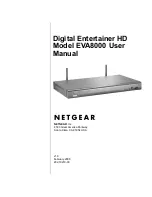
Introduction
62
Model 6081RC Network Access Server Getting Started Guide
8 • Configuring for bridged
Introduction
The 6081RC can be configured for bridged Ethernet operation to work in combination with the Model 3096RC
G.SHDSL TDM concentrator and the Patton Model 3201 G.SHDSL Modems as shown in
figure 40
. All
3096RC-to-3201 G.SHDSL links operate at a data rate of 1024 kbps, which offers a possible G.SHDSL trans-
mission distance of 21,000 feet (6.5 kilometers) over twisted-pair 24 AWG (0.5 mm) copper wire.
Figure 40. Bridged Ethernet operation diagram
This chapter describes:
•
The features and functions of the bridged Ethernet configuration
•
The factory-default parameter settings for the 6081RC
•
Procedures for using the 6081RC’s management interface to modify the factory default parameter values.
Note
For more information on configuring the Model 3096RC and Model
3201, refer to the user documentation that came with those products.
Bridged Ethernet operation
In bridged Ethernet applications, the 6081RC functions as an Ethernet hub for interconnecting G.SHDSL
access lines and an Ethernet LAN. Functioning as a hub, the 6081RC delivers data traffic to and from all inter-
faces (H.110 ports and up to three Ethernet LAN interfaces) by means of Ethernet bridging at the data link
layer (layer 2 of the Open Systems Interconnection (OSI) model). Ethernet data at customer sites is encapsu-
lated using the PPP/BCP protocol and sent over the DSL link to the 3096RC T-DACS. The Model 3096RC,
operating at the physical layer, terminates the DSL connection and maps arriving DS0s to the ForeFront chas-
sis H.110 bus. The 6081RC takes DS0 groups from the H.110 bus corresponding to individual DSL users and
connects at the PPP/BCP level. The 6081RC strips the PPP/BCP encapsulation and forwards user data to the
Ethernet port. Conversely, the 6081RC uses point-to-point protocol (PPP) for data delivery across the
G.SHDSL links, by encapsulating each BCP datagram in a PPP frame.
In general, network engineers may find the Ethernet bridging configuration (see
figure 40
) useful for any data
communication system requiring long-range connections between remote devices and an Ethernet LAN at a
central location. As a more specific example, a bridged Ethernet solution could be used when implementing a
real-world application such as an ISP for residential or business users. In such a scenario, access to Internet,
email, or other networking applications would be connected via G.SHDSL lines to a 3096RC and to the
6081RC via a H.110 bus, which would then provide bridged communications to the central ISP LAN.
192.168.200.98
Ethernet LAN
ForeFront chassis
DSL lines
192.168.200. 10/24
6081RC
3096RC
3201
3201
3201
3201
3201
















































